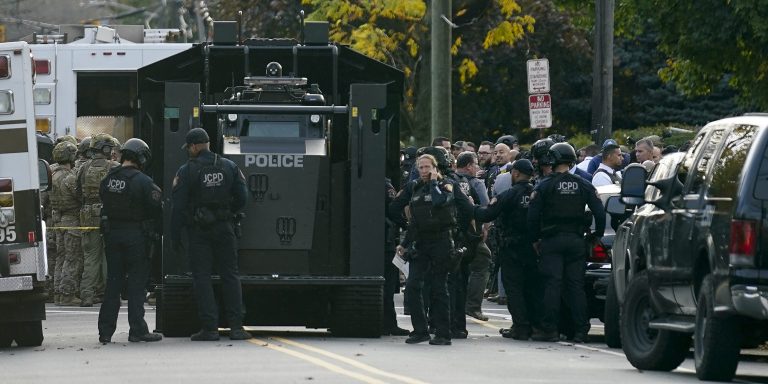INTELBRIEF
November 17, 2022
IntelBrief: Through the Looking Glass: Taking Stock of Domestic Violent Extremism in the United States

Bottom Line Up Front
- While the U.S. avoided political violence surrounding last week’s midterm elections, there is still growing concern over the domestic violent extremist landscape, with threats more diverse than at any point in recent memory.
- Domestic terrorism in the United States has been on the rise the past several years, including a major spike in violent incidents at demonstrations and protests in cities and urban areas.
- High-profile attacks in 2022 have spanned the ideological spectrum, demonstrating just how complex and unpredictable the state of domestic violent extremism is in the United States currently.
- Looking ahead, U.S. law enforcement and counterterrorism authorities remain concerned about the radicalizing impact of conspiracies and disinformation, particularly in the area of anti-government and anti-authority violent extremism.
While the United States avoided political violence surrounding last week’s midterm elections, there is still growing concern over the domestic violent extremist (DVE) landscape, with threats more diverse than at any point in recent memory. Last month, the Federal Bureau of Investigation (FBI) and Department of Homeland Security (DHS) published an unclassified report, “Strategic Intelligence Assessment and Data on Domestic Terrorism,” prepared for several Congressional committees, including the Permanent Select Committee on Intelligence. The U.S. government analyzes the DVE threat through five separate categories, including (1) racially or ethnically motivated violent extremism (REMVE); (2) anti-government or anti-authority violent extremism (AGAAVE), which includes a) anarchist violent extremists b) militia violent extremists and c) sovereign citizen violent extremists; (3) animal rights/environmental violent extremism; (4) abortion-related violent extremism; and (5) “all other domestic terrorism threats,” which includes “political and/or social agendas which are not otherwise exclusively defined under one of the other threat categories.”
Domestic terrorism in the United States has been on the rise the past several years. According to a report by the Center for Strategic and International Studies (CSIS), there has been an increase in both the number and percentage of domestic terrorist incidents at demonstrations in cities in both 2020 and 2021, with those years accounting for a 47 percent and 51 percent rise in attacks at demonstrations, respectively. CSIS data also showed an increase in the overall percentage of attacks and plots by the far-left last year (40 percent in 2021, up from 23 percent in 2020), although far-right extremists, including white supremacists and anti-government militias, still accounted for the highest percentage of plots and attacks, at 49 percent. Anti-Semitism and hate crimes against Asian-Americans and Pacific Islanders (AAPI) have also been on the rise, with prominent voices in music and sports lending their voices to anti-Semitic tropes and narratives. Many of these trends have been exacerbated over the course of the COVID-19 pandemic. At the end of 2020, the FBI was conducting approximately 1,400 pending domestic terrorism investigations, a number that nearly doubled in 2021 to 2,700 investigations, a significant portion of which were related to the January 6, 2021, insurrection at the U.S. Capitol. At the end of 2021, the FBI domestic terrorism investigations were focused on anti-government or anti-authority violent extremism (38 percent), anti-riot laws/civil unrest (31 percent), and racially or ethnically motivated violent extremism (19 percent). Only 1 percent of investigations were focused on animal rights/environmental violent extremism, with the remaining 11 percent focused on “all other domestic terrorism threats.” Abortion-related violent extremism garnered 0 percent of investigations at the end of 2021, though given the overturning of Roe v. Wade, that number is expected to rise and could do so significantly.
The data is incomplete for 2022, but one thing remains clear, the terrorist threat in the United States is driven by a complex patchwork of ideologies, grievances, and motivations. High-profile attacks in 2022 have spanned the ideological spectrum. In January, a hostage situation at a synagogue in Colleyville, TX was inspired by a lone actor’s attempt to secure the release of a federally convicted female supporter of al-Qaeda. In May, a far-right extremist motivated by racist, anti-Black, and anti-Semitic conspiracy theories attacked a supermarket in Buffalo, NY, where he murdered 10 innocent civilians in cold blood. That same month, an individual attacked a church in California that served the Taiwanese community, killing one and injuring five others while also placing Molotov cocktail-style devices around the church. There have also been devastating, high-profile attacks—a shooting on a Brooklyn, NY subway in April 2022 and a shooting at a 4th of July parade in Highland Park, IL—which cannot be clearly labelled terrorism, given unclear motives and incoherent social media footprints. In one week in August in the United States, four Muslim-Americans were targeted and murdered in an anti-Shia motivated attack, a far-right extremist attacked an FBI office in Cincinnati, Ohio, and famous author Salman Rushdie was stabbed by an American citizen who was inspired by the Iranian regime and the Islamic Revolutionary Guard Corps (IRGC). What used to be a fairly consistent and homogenous threat from Sunni jihadists, has given way to a variegated attack matrix, the most defining feature of which is the broad range of ideologies motivating violence.
Looking ahead, U.S. law enforcement and counterterrorism authorities remain concerned about the radicalizing impact of conspiracies and disinformation, particularly in the area of anti-government and anti-authority violent extremism. There are also several hot-button political and public policy issues that could serve as drivers for acts of violence, including nativism and immigration, abortion, and gun control. U.S. adversaries—including China, Russia, and Iran, among others—continue to maintain an interest in amplifying divisive narratives and incendiary rhetoric in an attempt to contribute directly to discord within the United States. Russian disinformation campaigns have sought to spread conspiracies about bioweapons and other false narratives, in an effort to inspire calls for violence against U.S. officials and institutions.